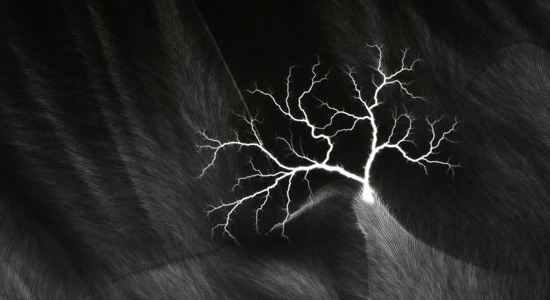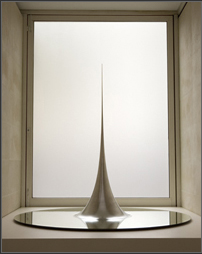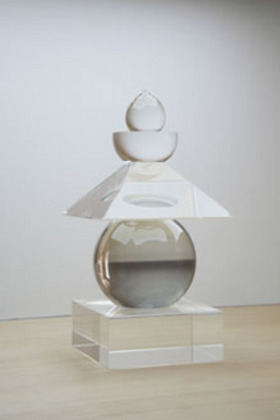
Smiling Sugimoto at Chinati
Hiroshi Sugimoto’s talk at Chinati, where he had an exhibition opening, revealed intelligence and humor of a time traveling artist-magician. One thread of his work, which includes not only photography, but architecture and theatre, is to reconnect with ancient sacred art through a focus on time and light. Though he calls himself a conceptual photographer, it is clear when Sugimoto uses his own body measurements for a stone tomb design that his projects are rooted in a contemplation of mortality. The wonder is how he reinvigorates universal forms like temples and seascapes that we imagine might be emptied out by now.

Hiroshi Sugimoto, Surface of the Third Order (2006)
His installation at Chinati consists of 24 identical small pagodas made of optical glass inlaid with distinct seascape photographs (instead of the Buddha’s ashes one would find in a traditional reliquary), and one large aluminum sculpture based on a mathematical function that approaches an infinite vanishing point. The tip of this high-tech machined form measures only 1mm, the narrowest the material could sustain. A tendency to think in terms of models, even models of models, and to turn reality into a model, is what makes Sugimoto a conceptual artist, with a mystical aspect. The stupa form is a also a model of the universe, representing earth or material, water, wind and even emptiness or becoming.
Apparently, the context of this exhibition in Judd-land is significant to Sugimoto in numerous ways. Seeing Donald Judd’s plywood box show at Paula Cooper Gallery in 1976 motivated him to make contemporary art by offering a very different example than had Ansel Adams in the realm of art photography. “If it’s this easy I can do it” he joked. Then, semi-seriously, he remarked that the vast scale of Chinati challenged him to make his works as small as possible. The theme of miniaturization, as a technique for the compression of vast time and space, returned when he showed an image of tomb jade in his collection that he has arranged into a “broken millimeter,” referencing Walter de Maria’s Broken Kilometer of 1979. Sugimoto’s oeuvre does have interesting overlaps with Judd’s work, including a predominant interest in repetition and variation, mathematical orders, clarity of form and method, and an elegant, precise finish. For both Judd and Sugimoto the individual element retains autonomy and identity , it is never subordinated to the group or pre-ordained. However Judd’s work places the emphasis on phenomenological and perceptual experience, while Sugimoto concedes more to transcendental or idealist visions and will allow metaphors and associations which Judd would avoid.

Five Elements, Optical Glass (2011)
One of the interesting things about seeing Judd’s work in Marfa is that a bit of the domestic and personal creeps into the work, softening the austerity. Sculptural experiments shade into furniture design while personal collections of bagpipes, native american objects, kitchenware, antiques share space with the objects he made. Sugimoto’s talk, purportedly about his own work, touched frequently on objects made by others from other epochs, as if boundaries of time, space and authorship meant little to him. It comes as no surprise that at one time he supported himself as an antique dealer and has since become a collector of ancient Buddhist and Shinto artifacts. There is no clear line between Sugimoto’s activities as an artist and as a collector since he actively reconfigures the objects he collects, which include burial jade, scroll paintings, noh masks, cuneiforms, old temple timber, and early Talbot negatives. He has been acquiring unprinted Talbot negatives in order to make positives, “seeking to return to the very origins of photography and see those first positive images for myself…like an archaeological explorer excavating an ancient dynastic tomb.” The analogy to archaeological exploration of tombs is not casual, since Sugimoto has even become a tomb architect.
The habit of situating himself in a very long time frame, from the primordial era into a post-human future seems quite unusual these frenetic days. But Sugimoto exclaims that our cultivated time has been very short; he is “very worried about the future.” This anxiety hasn’t zapped his enthusiasm or ruffled his serenity. He showed plans for an elevated east to west 100 meter lap pool that dramatically bisects Naoshima Island (where his redesigned Shinto temple sits) and would provide the ideal purification ritual before visiting the shrine. He has plans for a future seaside foundation that includes an underground chamber to be lit only by the winter solstice sun as well as a theatre for fifty people. A teahouse is already under construction. His traditional Japanese puppet theatre is looking for funding for a transportable noh stage. Next year his Talbot show, begun fourteen years ago, will open at Fraenkel Gallery in San Francisco. His “last seascape show,” last because he can no longer safely transport his large format camera or film by airplane, will open in a few weeks at Pace Gallery in NY.
Sugimoto’s light comedic presence suffuses all his philosophically engaged projects. A film of him in the darkroom playing with electric currents elicited a chuckle and the comment “here I am amazing myself”. He took great pleasure in showing the audience youtube footage of a U2 concert featuring his seascapes as panoramic rock stage decoration. Another video showed Sugimoto dressed fabulously in traditional formal attire, on the floor of a stage with his puppet theatre group, formally petitioning for money 18th century Japanese style. When the potential funders expressed concern about exactly how the money would be spent Sugimoto exaggeratedly extended his hand and said “don’t worry, I’ve already spent it.” Understanding neither Japanese, nor the relevant conventions, one nonetheless recognizes the playful clown in Sugimoto who enjoys his own performance even in the midst of it.
